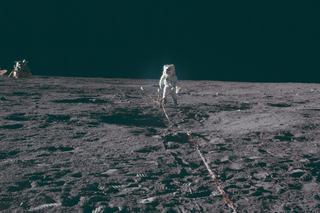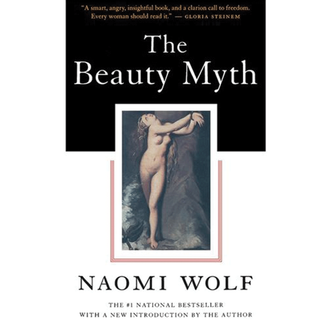
Why The Moon’s Cultural Legacy Still Endures
From old goddesses to the new space race, the moon’s power pulls at mankind.

In 2014, as a part of her collection ‘American Landscape,’ Madrid-based fashion designer Ana Gonzales released upon the runway a floor-length strapless gown and sweatsuits screen-printed with digitally printed images of the lunar landscape. Her inspiration for her fall 2014/15 collection were road trip movies and vast American landscapes, of which perhaps the final frontier is the moon. Gonzalez states on her website that the “primitive American dream represents the desire to start from scratch and eventually own land and call it home … the path that is still taken today across that immense American land in search of a new life, the freedom to choose, and finding the means to continue living,” which was the basis for her creations. The collection was almost prophetic of the moon reentering public imagination: U.S. President Donald Trump recently decided to push up to 2024 the deadline for NASA’snext moon landing mission, Artemis, named after the Greek moon goddess. If all goes well, men, and maybe everybody else will walk the moon again.
Mankind’s primal awe at the distant and the alien has always diverged into reverence and want. The moon wasn’t formed with the power to sway our minds; it was given that power by us. And in her long, cross-cultural reign, as the idea of her power grew stronger, so has our need to conquer it. While there is a case to be made for the pure scientific importance of lunar exploration, the real reason man craves reaching the moon is to derive power from possessing it.
Thus, as men grew a taste for science, so did their reasons to canvass the moon’s landscape. Georgina Kramer, a scientist who studies the moon told Vox, “The moon has recorded impact processes that have gone on throughout the entire solar system.” Each crater on the moon remains unchanged, some dating back as far as the moon’s own origin via the collision of Theia and Gaia (the Earth) about 3.5 billion years ago. There is also the possibility of life, from frozen water and moderate temperatures on the lunar poles. This naturally translates to our possibility of life in space. A possibility that mankind has been inching towards ever since the first spaceship rose above the atmosphere.
The primitive versions of curiosity and postulation often presented themselves as reverence. The new moon mission’s name is no coincidence; much like Apollo, the namesake of predecessor missions, Artemis is a powerful deity, under whose godly ambit comes the moon, hunting, wilderness, and fertility. To mankind, the moon personified the divine feminine. She was no raging ball of fire like the hyper-masculine sun, but an understated, volatile force that pulled entire oceans and commanded much of man’s exploratory longing. To the human mind, the moon soon controlled everything, from when a woman bled, to the depths of our innermost desires. Our obsession was the moon’s great power. This obsession also bore art, culture, music and of course, capitalist branding.
While the moon’s cultural heft grew, so did attempts to reach it. During the Cold War, it was the ultimate prize that the U.S.A and the U.S.S.R vied for. The race to showcase scientific might was tense and highly competitive. Tom Wolfe, writing for the New York Times, compared the Cold War’s Space Race to single combat, where, “Cosmonauts and astronauts didn’t fight hand to hand and behead one another. Instead, each [the American and the Soviet] side’s brave champions, including one woman (Valentina Tereshkova), risked their lives by sitting on top of rockets and having their comrades on the ground light the fuse and fire them into space like the human cannonballs of yore.”
Eventually, the terse showcase of nationalist brawn between both nations ended when the U.S. put the first man on the moon. The Soviet soon crumbled and the U.S. held on to the champion’s wreath, while many nations slowly started sending their own probes to chart paths toward the moon.
Gil Scot Heron, the renowned blues singer, and poet took a contrarian approach. In his poem, ‘Whitey On The Moon’, he registered a searing critique of the power structures at play in the moon landing. Using the lens of racial inequality, Heron wrote,
‘A rat done bit my sister Nell.
(with Whitey on the moon)
Her face and arms began to swell.
(and Whitey’s on the moon)
I can’t pay no doctor bill.
(but Whitey’s on the moon)
Ten years from now I’ll be paying still.
(while Whitey’s on the moon)’
From Heron’s perspective, the race to reach the moon was stripped bare to reveal the skewed priorities of people who controlled political offices. What good does a strange man stepping on a faraway blob of light in the sky do for the lives of the destitute and the marginalized?
While NASA did collect path-breaking data and lunar imagery, Wolfe postulates that the real Space Race, from the American perspective, was an aggressive push to pull up nationalist morale by defeating the Soviet Union. When John. F. Kennedy announced the national goal of putting a man on the moon by the 1960s, he did so as a last-ditch attempt to drag away the conqueror’s power from the Soviet Union, which was miles ahead in terms of space exploration.
Again, the moon was the final frontier, the great fantastic other that united the masses, this time to watch a human champion conquer her, rather than to be worshipped. When the first man set foot upon the moon, the great race for national superiority was won, celebrated with much fanfare — then the U.S.promptly moved on. In modern times, keeping up with his mission to ‘Make America Great Again,’ President Trump appears to be a fan of the same tactic: to harness the might of the great conqueror by making big promises, fueling nationalist zeal and shrouding urgent issues that need equal attention.
However, the current stakes are much higher. With the Earth’s human-sustaining environment rapidly disintegrating, the scope for space exploration has evolved way beyond the scientific curiosity PR line.
Buzz Aldrin, in conversation with Marcie Bianco for NBC, stated, “it is imperative that we talk about space exploration in terms of ‘migration’, rather than using words like ‘colonize’ or ‘settle’.”
Though the moon’s allure remains strong, mankind has moved its next great Space Race to Mars, because the likelihood of human survival is greater there. This time, the messaging feels more ominous, and possibly more honest. To survive extinction, man must conquer the hyper-masculine Roman god of war.
Aditi Murti is a culture writer at The Swaddle. Previously, she worked as a freelance journalist focused on gender and cities. Find her on social media @aditimurti.
Related


Indian Women’s Football Surges Ahead Without Resources, All Thanks To Its Players
